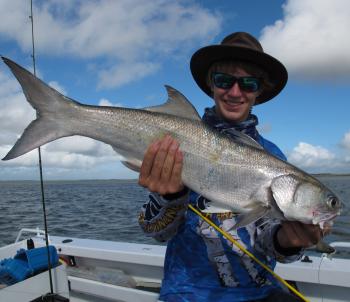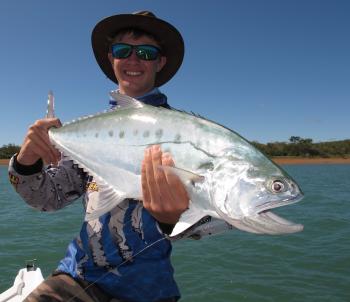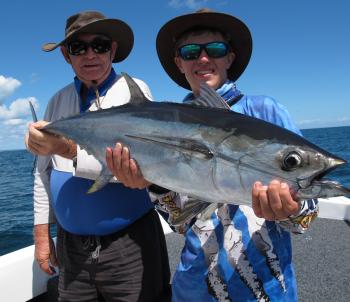Summer has sadly come to an end but the fishing has been as good as gold. The rivers at this time of the year have generally shut down, but with the warm weather hanging around, the fish are extending their stay. The barra and salmon are biting and are generally found in deeper holes upstream past Beaver Rock.
Large schools of blue salmon are schooling up around the mouth of the Susan River, and are quite happy to eat just about anything, but large soft plastics and vibes seem to have the best effect – I’ve had great success with the variety of Storm soft plastics such as the Live Kickin’ Minnow and the SX Soft Vibe. While some may consider blue salmon a bad table fish, they are actually quite delicious if bled and iced straight away. They have very white, slightly oily flesh similar to tailor. As with any species – limit your kill and don’t kill your limit.
Offshore tuna have been crazy, smashing schools of baitfish and creating acres of boiling water where they feed. Longtails are the prize, but they are cruising with mixed schools of mac tuna and bonito, so which species you pull out of the school is a lucky draw.
Most of the longtails are around 6-8kg but some of the bigger fish reach the 15-25kg mark. They seem to prefer smaller offerings at this time of the year and the main baitfish they feed on are small pilchards and hardiheads. Larger tuna stalking the shallow flats feed on large squid and small fish surrounding the coffee rock patches. The best offerings are small soft plastics, metal slugs and flies, and on the flats a large stickbait or plastic is probably your best bet.
Aside from tuna, other big pelagics such as Spanish and spotty mackerel have been lurking in the depths. While spotty mackerel can be caught on slugs and soft plastics, your best bet for a big Spaniard is to troll big minnows around the feeding tuna schools where the macs hunt.
It is a good idea to have one lure rigged up with a shallow runner, or stickbait and the other a deep diver to cover more ground. It is also important to use a short 10-30cm trace of wire for mackerel, especially Spaniards to prevent them from biting off your precious lures. Spotty mackerel are fine to eat but Spaniards are known carriers of ciguatera and should be released as soon as possible. This is also the same for barracuda, which are a common by-catch when fishing for mackerel.
Snapper should start to turn up on the reefs, alongside the regular catches of grunter, pearl perch and red emperor. These fish can be caught on soft plastics, micro-jigs and of course livies from crabs to prawns and even yakkas. Large schools of queenfish and school mackerel are also showing up around the inshore reefs and these can be caught on slugs and soft plastics.
Big longtails are hanging around on the flats, and goldies, queenies and even GT are swimming beside them so make sure you target the flats with a fly rod. Lately Ungowa has been quiet with no real good number of fish showing up, but in the next few months barra, grunter and of course threadies should begin to school up around the rocky ledges. Don’t forget to pack your deep divers when heading down that way.
| While autumn and winter may be recognized as a cold fishless time of the year, if you know where to look and what lure or bait to use, it can be as successful as fishing the warm summer months. Good luck to all anglers over | the autumn months and don’t forget to think like a fish. |
|---|

Just one many good-sized blues found schooling up in the river lately. This one fell for a Storm Live Kickin’ Minnow.

A nice-sized spotty mackerel caught on a slug. These fish are great fun to catch and even better to eat!

A beautiful queenfish caught on the flats. This fish violently smashed one of Storm’s new stickbaits, the Arashi Top Walker 11 that ended up pinned to his chest.

The author and his grandad display the average-sized longtail to be caught in and around Platypus Bay at this time of the year. The fish were a little finicky but eventually succumbed.

‘Match the hatch’ is a very important thing to consider when chasing tuna, as generally once they begin feeding on a certain baitfish they will not eat anything else. A Gomoku micro-jig was as close as we were going to get to the small pilchards on this p




